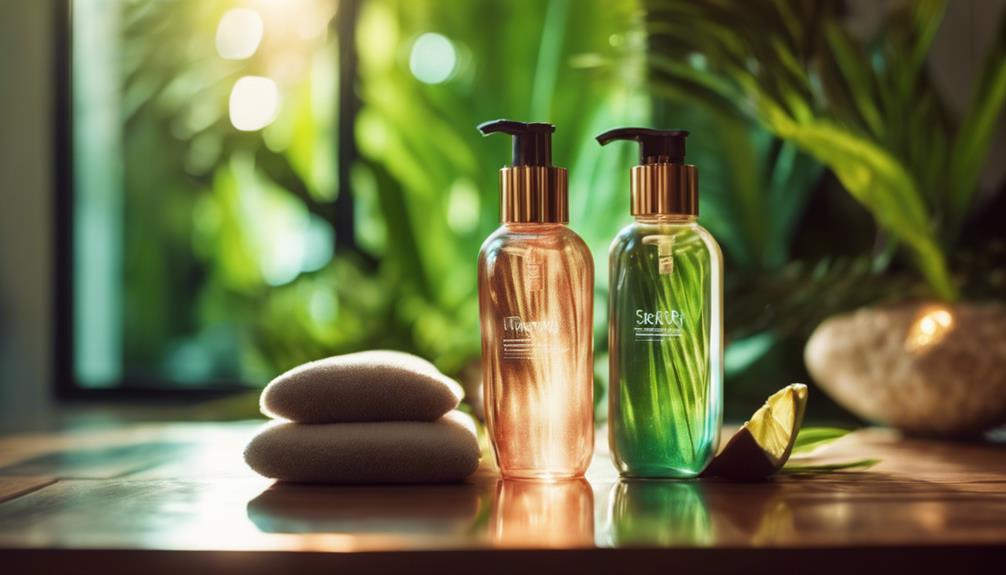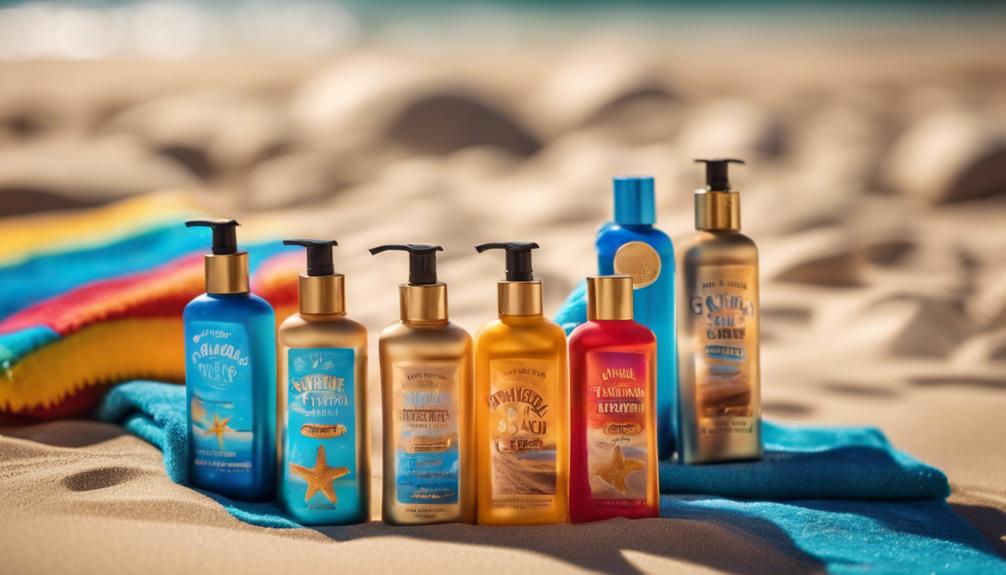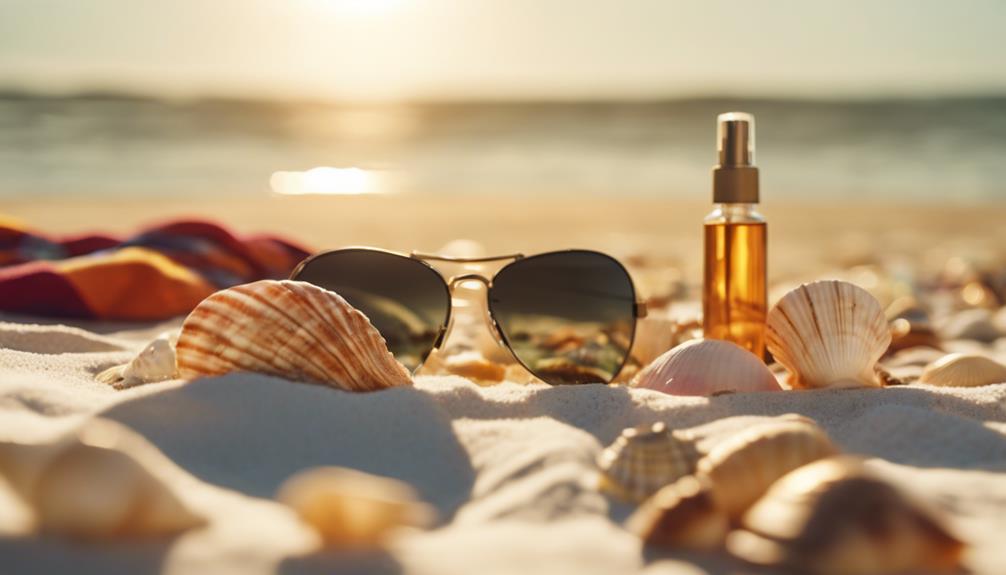To achieve a radiant tan, you'll want to pick lotions specifically suited to your skin type and desired results. Look for bronzing lotions with hydrating ingredients, like coconut oil and vitamins, to keep your skin soft. Brands like Ed Hardy and Millennium Tanning offer excellent options, ensuring deep color and moisture. Remember to exfoliate before applying and reapply as needed to maintain your glow. Avoid overloading on bronzer strength; lower levels often yield more natural results. If you keep going, you'll discover more tips and tricks to perfect your tanning experience.
Key Takeaways
- Choose bronzing lotions with suitable bronzer strength; lower for gradual tans, higher for instant results.
- Opt for hydrating ingredients like coconut oil and vitamins to nourish your skin while tanning.
- Exfoliate your skin before application to ensure an even and smooth tanning process.
- Select lotions with pleasant scents to enhance your tanning experience without causing irritation.
Key Considerations for Tanning Lotions
When choosing a tanning lotion, it's essential to take into account your skin type and desired results to avoid irritation and achieve an even tan.
Start by selecting bronzing lotions with a pleasant, non-irritating scent, as this can enhance your tanning experience.
Look for products enriched with hydrating ingredients like coconut milk and vitamins A, C, and E, which nourish your skin.
Evaluate the bronzer strength—lower levels (5X-15X) are great for gradual tans, while higher levels (50X-100X) offer instant results.
Assess the price per ounce to guarantee you're getting value for your budget.
Benefits of Tanning Lotions
Tanning lotions offer a range of benefits that enhance your tanning experience and results. By using these products, you can maximize your tan while keeping your skin healthy and hydrated.
Here are some key advantages of tanning lotions:
- Enhanced Results: Formulated with bronzing agents and accelerators, they help you achieve a deeper, more radiant tan.
- Skin Hydration: Rich in moisturizing ingredients like coconut oil and cocoa butter, these lotions keep your skin from drying out during tanning sessions.
- Color Protection: They help maintain your tan's longevity and prevent fading, ensuring your color stays vibrant.
- Even Application: Tanning lotions promote a uniform spread on your skin, reducing the risk of streaking and uneven patches.
With these benefits, you can enjoy a beautiful, long-lasting tan.
Top Tanning Bed Lotions

To achieve the best results from your tanning sessions, choosing the right tanning bed lotion is key, as it can greatly enhance your tan while providing skin benefits.
Look for high-quality options like Millennium Tanning Solid Black 100X for deep color or Ed Hardy Coconut Kisses for hydration and tattoo protection.
If you prefer a budget-friendly choice, European Gold Flash Black 3000X offers effective bronzing with time-release DHA.
For those who want maximum intensity, b.tan UV Tanning Bed Lotion features x2000 tanning intensifiers.
Remember to assess your skin type and select lotions that cater to your needs, ensuring a beautiful, radiant tan while keeping your skin nourished and healthy.
Effective Application Tips
Achieving an even and radiant tan starts with properly exfoliating your skin before applying the bronzing lotion. This step removes dead skin cells, ensuring a smooth foundation for your tan.
Follow these effective application tips for ideal results:
- Apply Evenly: Use your hands or a tanning mitt to spread the lotion uniformly, avoiding streaks or patches.
- Reapply as Needed: After sweating or swimming, reapply the lotion to maintain your tan's intensity.
- Wash Hands: Always wash your hands thoroughly post-application to prevent stained palms.
- Moisturize After: Follow up with a moisturizer to keep your skin hydrated and assess the depth of your tan.
Misconceptions About Tanning Lotions

Many people believe that darker lotions guarantee better results, but quality varies greatly between brands and skin types. You might think that using a high-number bronzer will automatically give you a deep tan. However, results depend on your unique skin type and how well the lotion interacts with it.
Additionally, indoor tanning doesn't replace the need for sunscreen; you still need protection from UV rays. Be aware that not all bronzers are created equal; some may cause breakouts if they're not suited for your skin.
Current Market Trends
The tanning lotion market is seeing a surge in demand for vitamin-rich formulations that prioritize skin nourishment and natural ingredients. Consumers are more conscious of their choices, looking for products that not only tan but also enhance skin health.
Here are some current trends shaping the market:
- Natural Ingredients: Preference for lotions infused with organic components like coconut oil and aloe vera.
- Anti-Orange Technology: Rise in popularity of products designed to prevent unwanted orange hues.
- Fragrance Variety: Increased options for pleasant scents, enhancing the overall tanning experience.
- Skin Health Focus: Growing awareness of the importance of skin health, leading to a demand for hydrating and nourishing formulas.
These trends reflect a shift towards smarter, healthier tanning choices.
Customer Feedback Insights

Customer feedback highlights quick absorption and a non-greasy feel as key factors that enhance user satisfaction with tanning lotions. Users appreciate how these features allow for easy application and a comfortable experience. Many reviews note the importance of hydration and natural-looking results, while some express concerns about scent strength.
| Feature | Positive Feedback | Areas for Improvement |
|---|---|---|
| Absorption | Quick and efficient | Some prefer longer-lasting |
| Greasiness | Lightweight feel | Few find it slightly oily |
| Hydration | Skin feels moisturized | More hydration desired |
| Scent | Pleasant and invigorating | Strong scents can be off-putting |
| Tan Appearance | Natural and even | Some report temporary staining |
Skin Type Compatibility
Understanding how different tanning lotions interact with your skin type can greatly enhance your tanning experience and results. Choosing the right lotion guarantees you achieve a beautiful tan without unwanted side effects.
Here are some key considerations for skin type compatibility:
- Sensitive Skin: Avoid harsh chemicals; opt for gentle, hypoallergenic formulas.
- Dry Skin: Look for lotions rich in hydrating oils and butters for added moisture.
- Oily Skin: Choose oil-free, non-comedogenic options to prevent breakouts.
- Fair Skin: Use lower bronzer concentrations to prevent orange hues and achieve a natural glow.
Popular Tanning Lotion Brands

Many popular tanning lotion brands offer unique formulations that cater to diverse skin needs and preferences.
For instance, b.tan is known for its vegan and cruelty-free options, while European Gold provides budget-friendly and effective choices.
Ed Hardy stands out with its distinctive fragrances and skin-benefiting ingredients.
If you're looking to enhance your bronzing, TAN ASZ U specializes in protecting body art and improving tanning results.
Australian Gold has earned a long-standing reputation for quality and effectiveness.
Each of these brands focuses on different aspects, from hydration to scent, ensuring you can find a product that matches your tanning goals.
Explore these brands to discover which one aligns best with your tanning experience!
Choosing the Right Tanning Lotion
Selecting the right tanning lotion involves evaluating your skin type, desired results, and ingredient preferences to guarantee an ideal tanning experience. Here are four key factors to take into account:
- Skin Type: Identify whether you have sensitive, dry, or oily skin. Choose a lotion that caters to your specific needs to avoid irritation or breakouts.
- Bronzer Strength: Decide between gradual or instant tanning results. Lower bronzer concentrations work best for subtle tans, while higher levels deliver quicker results.
- Hydration: Look for lotions with nourishing ingredients like coconut oil or vitamin E to keep your skin moisturized.
- Fragrance: Reflect on your scent preferences, as some lotions can have strong odors that may not be enjoyable.
Frequently Asked Questions
How Long Should I Wait Before Showering After Applying Tanning Lotion?
After applying tanning lotion, you should wait at least 6 to 8 hours before showering. This allows the bronzers to fully develop and guarantees you achieve the best results from your tanning product.
Can I Use Tanning Lotion on My Face?
You might worry about breakouts, but you can use tanning lotion on your face. Just choose a formula designed for facial use, apply evenly, and don't forget to moisturize afterward for best results.
Is It Safe to Use Tanning Lotion While Pregnant?
It's generally advised that you avoid using tanning lotions during pregnancy. Ingredients in some lotions may not be safe for you or your baby, so consult your healthcare provider for personalized recommendations before applying any products.
What Should I Do if I Experience a Reaction to the Lotion?
If you notice a reaction to the lotion, don't panic! Rinse the area with cool water, stop using the product, and consult a healthcare professional for advice. Your skin deserves the best care possible.
How Often Can I Use Tanning Lotion for Optimal Results?
You can use tanning lotion every time you tan, but limit it to two to three times a week for ideal results. Always monitor your skin's response and adjust frequency based on your skin's health.
Conclusion
In your quest for that perfect tan, choosing the right lotion is key.
Keep your skin soft and sun-kissed by selecting a product that suits your needs.
Remember, a little preparation goes a long way in achieving a dazzling, delectable glow.
So layer on the love with the right tanning lotion, and bask in the beauty of your bronzed brilliance.
With the tips and insights you've gathered, you're ready to shine and showcase your stunning tan!










